



A new year to look at the fabulous Saturn. The rings are closing up nicely now getting ready for the ring plane crossing in September 2009. The rings will also be almost edge on in early 2009. I hope this will enable some interesting views of the moons and their shadows, if the seeing conditions are good enough to image them.
This year Saturn is quite high in the sky but it is gradually getting lower each year as it slowly marches on towards it's spring run of oppositions. Opposition this year was on the 8th of March. I discovered this year that imaging Saturn with a red filter brought out the detail on the disk very nicely, without the loss of brightness I suffer when using the IR filters. On nights when the transparency of the sky was poor, the red filter (without a IR-UV block) produced some good images.
|
10th January 2008 My first decent image of Saturn this year. Very noticeable is how much the rings have tightened up since last year. Another year and they will be almost completely closed into a thin line. The mono image is taken with a black and white CCD toucam and a 685nm IR pass filter, effectively passing wavelengths from 1000nm to 685nm. The colour image on the right is a standard RGB ToUcam and the centre image is the IR mono image colourised with the RGB image. |
|
|
|
|
|
|
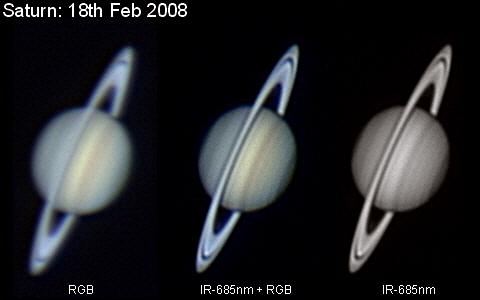 |
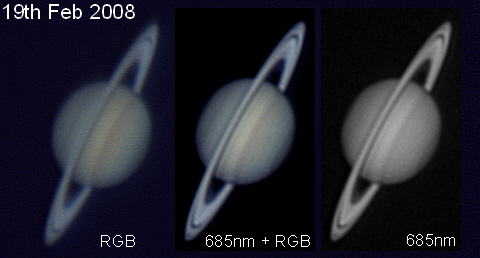 |
The three image selections from the 16th, 18th amd 19th of February show clearly what a difference the sky's conditions can make. The 18th of February gave the best conditions in IR, however the 19th of February seemed to give slightly better image quality for visible light, RGB image. February the 18th shows some particularly nice detail of the banding in the southern hemisphere, brought out nicely in the colourised image at the centre. Also quite noticeable is the central, narrow, equatorial band. The slightly murkier, hazier, sky conditions on the 19th of February helped to bring out the fainter inner C-ring. |
| 24th February 2008. I caught Saturn less than 24 hours after opposition this year. The opposition effect on the rigs is quite marked. It is a similar effect to the full moon, where the rings (or the moon) are brighter than you would expect, when they are opposite the sun in the sky and reflecting light almost directly back to us. In the image below, the ring brightness when compared to the planets brightness is markedly greater than at other times. I also over processed the IR image to bring out the moons that are otherwise invisible in the image - far right image |
|
|
|
|
|
|
|
| 4th March 2008. (above) Had a good nights imaging, very clear transparent and reasonably steady skies. I had enough time to image at several different wave lengths. One observation is that the narrow equatorial band is more pronounced the further into the infrared I imaged. In the 742nm image it is fairly obvious, in the the green image it is all but invisible. Also notice the storm on the stretched image. This corresponds nicely with other images I have seen taken around the same time. |
9th March 2008. (below) Another good nights imaging, though I used less filters due to the less transparent skies making the Saturn image rather faint. The red filter seems to bring out the banding in the southern hemisphere nicely and ironically, given my comment for the 4th of march the equatorial band is more prominent in the red filtered image than the 685nm image. Over processing brought out some of the moons that were otherwise hidden in the image. |
|
|
|
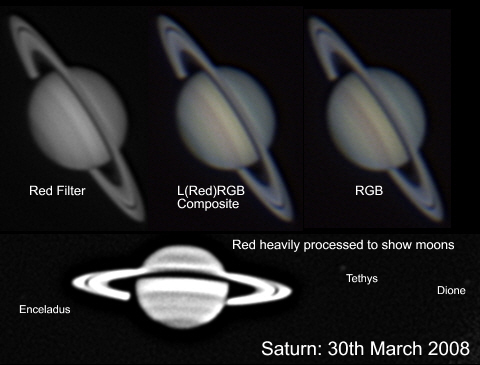 |
30th March 2008: (left). |
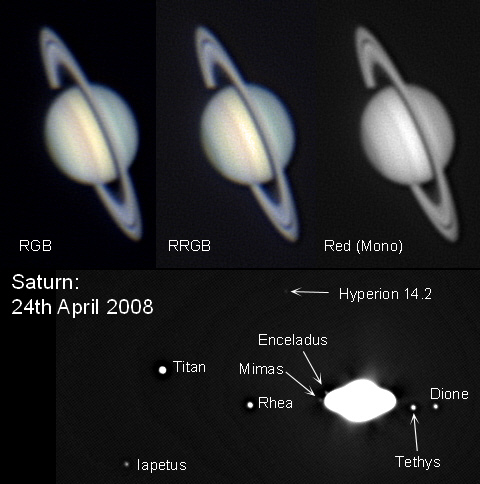 |
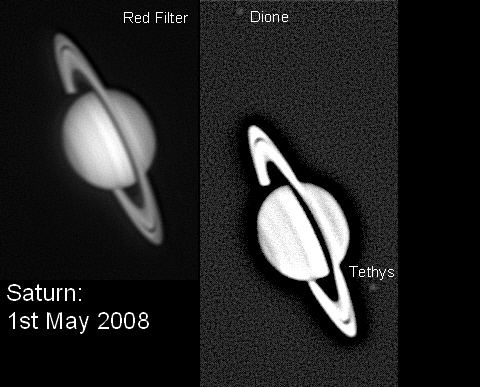 |